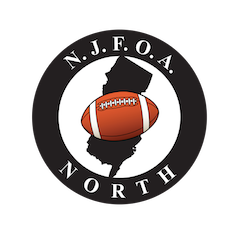Should You Throw?
 Archival Repost from Referee Magazine - 2004
Archival Repost from Referee Magazine - 2004
You’re keying the wide receiver going down the sideline. You see the defensive back grab the receiver’s jersey. Your hand instinctively reaches for “yellow.” How hard was that?
In truth, to effectively determine when a contact foul has occurred it takes a more rigorous programmed thought process. While this process can be applied equally well for all contact fouls, administrative fouls such as pre-snap infractions (false start, illegal motion, illegal shift, etc.) and equipment violations are a different animal. In general, such fouls must be rigorously enforced without regard to impact on the play or the “degree” of violation. Newer officials often have a difficult time distinguishing between the two, and as a result tend to be overly “technical” in dropping a flag for fairly insignificant contact fouls. I hope this article might assist them in developing a better feel for how to properly assess contact fouls.
There’s not a whole lot of time to work through this process—a few seconds max, but as you become more experienced, it will become second nature. Different people talk about it in different ways, but it all boils down to the same thing—See the contact, Read the play, Assess the impact, and Decide!
See the Contact - The first step is to see the action, not just a piece of the action, not just the end of the action—but the entire action.
How many times have you turned just in time to see a defensive player fall flat on his face where you’re pretty sure that he was hit in the back by an offensive blocker? You feel the irresistible urge to drop the hankie. But…are you sure that the hit (if there was a hit) was inthe back. Did you really see it? Might it have been from the side? Or maybe the defender turned his back just before the hit in an attempt to draw the flag.
If you’re asking all of these questions and don’t know the answers “cold,” you probably didn’t see the whole play. Leave the flag in your pocket and continue officiating. Yes, you might take some heat, but better to miss a real foul (just don’t do it too often!) than call a ‘phantom’ one. As one of the Axioms of Football Officiating says: “If you think you saw a foul, you didn’t.”
So let’s assume that you have seen the entire action from a position that allowed you to see clearly exactly what happened. At this point we have what I’ll refer to as a “suspect” foul, i.e. contact that has the initial appearance of illegal activity. But it must be processed further. The next step is to Read the Play…
Read its Relevance - So now you have a suspect foul rattling around in your brain. The next step is to take a quick look at the environment—the play in progress—to see what’s going on and whether your suspect foul has the potential to materially impact the game. A quick glance will tell you where the ball is headed and whether it’s getting there by run, pass, or even by kick. You might consider this step an evaluation of the “relevance” of the contact. How pertinent is it to what’s happening on the field?
The classic example of reading the play is when there is a suspect for offensive holding. Unless it’s a flagrant ‘takedown,’ almost every official worth his salt will pass on calling a hold that’s not at the point of attack, i.e. the lateral position on the field where the runner is or soon will be. A quick read of the play gives you a measure of the relevance that the suspect foul has to the play.
We can also go back to the first situation we discussed. You see that wide receiver going down your sideline and observe the defender reach out and grab a handful of jersey. Now…read the play. Does this suspect foul possibly have an opportunity to impact the play in progress? If you take a quick glance into the offensive backfield and see
that the play is a sweep to the other side of the field, you’ve pretty much got nothing. A little discrete conversation with the DB about “watching his hands” might go a long way toward preventing a future foul, but for this play, by all means, keep the flag in your pocket!
Now let’s go to the other extreme: Imagine that when you take that quick glance back toward the line of scrimmage, you see the QB launch a pass down the sideline toward your receiver. Now it’s very clear that the defender’s actions may (and we’re still saying “may” at this time) have a material impact on the play.
And then there’s that middle ground that good officials have the ability to clearly see and react to. What if when you look back, you see the QB looking toward your receiver? But then he suddenly tucks the ball and gets sacked. Is it possible that the defender’s action might have prevented him from throwing to your receiver? That contact may indeed be relevant even though no pass has been thrown. A tough judgment call, but one you need to be able to make. At this point, we move to the third step in our thought
process—Assess the Impact…
Assess its Impact - Let’s face it, there are holds, and there are HOLDS. Not all holds were created equal. The same is true for virtually every infraction in the game of football—pass interference, blocks in the back, illegal use of the hands, etc., etc.
If we’ve reached this point in the thought process, we have a potential infraction that we’ve determined might have an impact on the play in progress. Now we need to evaluate the action to determine if indeed it does. We’re now at a point where we assess the degree of impact on the play. We need to determine if the potential infraction either (a) created a material advantage for the offending player, or on the contrary (b) put the offended player at a significant disadvantage.
Consider the following play: The QB throws a pass up for grabs. The receiver and defender settle under it waiting for it to come down. Each player reaches out and lays his hands on his opponent, sort of feeling exactly where he is. They might even exert a little pressure on each other, but neither player is displaced from his position. Both remain under the ball waiting to leap for the pass when it ultimately arrives. Assess the contact. Did the either player’s contact against his opponent give him a material advantage? Did the contact put the opponent at a significant disadvantage? From the description here, it doesn’t seem so. But consider the same situation where the offensive receiver shoves the defender just before the ball arrives so that he is displaced from his position under the ball, creating separation and giving the receiver an unmolested attempt to catch the pass. Now the story is different. You’ve got a pretty classic example of offensive pass interference.
Or go back to our original play. As the defender grabs the receiver’s jersey, the receiver runs right through the grab maintaining his stride and his pursuit of the pass. The momentary grab in no way restricts the receiver and now the defender is left to pursue him from behind. Should you flag this? Maybe, but probably not. Now consider the same situation where the grab materially alters the receiver’s path to the ball. Maybe it causes him to break stride and slows him down allowing the defender to remain with him. In this case, not only did the grab materially disadvantage the receiver by restricting his movement, it also gave the defender a significant advantage by slowing the receiver down so that the defender could keep pace with him. This defensive hold must be flagged.
The same type of analysis can be applied to any potential contact foul that you observe. Let’s turn the tables and consider a potential offensive hold. A slight hook of a defender from which he quickly pulls away with no apparent restriction to his movement should probably be ignored, while a grab that restricts the defender at the point of attack to the extent that he cannot naturally pursue the runner probably deserves a flag.
After Seeing the play, Reading the relevance of any questionable contact to the play in progress, and Assessing the actual degree to which the contact did impact the play, we’re ready to Decide…
Decide - This step takes virtually no time whatsoever. It’s simply a decision point that processes what you’ve determined from the prior steps. If you saw the whole action (See), established that the action is relevant to the play that’s unfolding (Read), determined that either someone gained a material advantage or was put at a significant disadvantage (Assess), then you drop the flag. If any one of those steps failed to produce an unequivocal positive answer for you, you will be better off passing on the foul.
About The Interpreter:
Bob Masucci is a retired information technology contracts manager. Residing in Clinton Township, NJ, Bob is a 43-year football official. During these years as a top official, he has officiated in countless state playoff games, including an infintesmal amount of NJSIAA State Finals.
As an active member and current 2nd Vice President of the North Jersey chapter of the New Jersey Football Officials Association, he has participated in the training and mentoring of new officials and has independently developed a wide array training materials that are used by Referee Magazine and countless football officials associations nationwide.
This work represents the opinions of the author and possibly others. The principles expressed have been arrived at through years of experience and interviews with other officials at all levels of football. They represent how the rules of football are applied at various levels and in various regions. Each reader must filter this work through his own philosophy and through the standards established by his own local associations and/or conferences. Likewise, it is intended to assist officials in the proper application of NF/NCAA football rules and techniques. It is not the definitive word. Should any information included herein be in conflict with any National Federation publication or any NCAA publication, those documents shall prevail.
